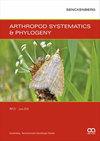基于成虫期和未成熟期的全证据法分析杜富里尼部落(双翅目:速蝇科)的系统发育
IF 1.8
2区 农林科学
Q2 ENTOMOLOGY
引用次数: 3
摘要
摘要Dufouriini是一个分布于世界各地的塔钦族,由13属51种组成,由成年鞘翅目的寄生蜂组成。Dufouriini的系统定位一直存在争议。目前,它被放在Dexiinae中,但之前被放在Phasiinae和Voiinae中,甚至已经有了亚科的地位。Dufouriini的划界和组成也一直存在争议,无论它是一个单一的部落,还是分为两个(Dufouriii和Freraeini)或三个(Dufouriini、Oestropasiini和Freraeini)部落。在此,我们首次利用成年和未成熟阶段的形态学数据,基于全部证据对Dufouriini进行了系统发育分析。分类采样包括Dufouriini的所有属(包括Oestropasiini),以及属于Freraeini的属,Freraeinni是一个历史上有亲缘关系的部落。数据矩阵包括该类群中的35个物种和22个属,以及由卵、一龄幼虫、蛹和成虫构建的185个特征,包括雌末和雄末以及受精囊。系统发育分析表明,Dexiinae是与Phasiinae相关的副系,因为分支(Freraeini(Dufouriini+Oestropasiini))与Phasiina e的亲缘关系比Dexiinaa更密切。Dufouriini、Oestropasiini和Freraeini被恢复为独立的单系部落,并得到了一些突触形态的有力支持。Oestropasiini已重新验证。提出了一个新的同义词:Comyopsis Townsend syn。埃贝尼娅·麦克夸特的十一月。因此,Ebenia fumata(Townsend,1919)被Ebenia fumata(Wulp,1891)命名为“Ebenia preoccupatum”,因此我们通过指定新的替代名称Ebenia neofumata Santis和Nihei来改变其特定的称谓。Mesnilana属和Rhinophoroides属从Dufouriini中移除,并暂时归入Palpostomatini中。最后,Cenosomastat。rev.,以前是一个Oestropasia亚属,现在被重新确认为属。本文章由计算机程序翻译,如有差异,请以英文原文为准。
Phylogenetic analysis of the tribe Dufouriini (Diptera: Tachinidae) using a total evidence approach based on adult and immature stages
Abstract
Dufouriini are a worldwide distributed tachinid tribe comprised of 51 species in 13 genera, made up of parasitoids of adult Coleoptera. The systematic positioning of Dufouriini has been controversial. Currently, it is placed within Dexiinae, but was previously placed in Phasiinae and Voriinae, and has even had the status of subfamily. Delimitation and composition of Dufouriini has also been debated, whether it is a single tribe or divided into two (Dufouriini and Freraeini) or three (Dufouriini, Oestrophasiini and Freraeini) tribes. Herein, we present the first phylogenetic analysis of Dufouriini based on total evidence using morphological data from adult and immature stages. The taxonomic sampling included all genera in Dufouriini (including Oestrophasiini) and also the genus belonging to Freraeini, a historically related tribe. Data matrix comprised 35 species and 22 genera in the ingroup, and 185 characters constructed from eggs, first instar larvae, puparia and adults, including female and male terminalia and spermathecae. The phylogenetic analysis recovered Dexiinae as paraphyletic in relation to Phasiinae, since the clade (Freraeini (Dufouriini + Oestrophasiini)) is more closely related to Phasiinae than Dexiinae. Dufouriini, Oestrophasiini and Freraeini are recovered as separate monophyletic tribes, strongly supported by a number of synapomorphies. Oestrophasiini is revalidated. A new synonymy is proposed: Comyopsis Townsend syn. nov. of Ebenia Macquart. Accordingly, Ebenia fumata (Townsend, 1919) is nomen preoccupatum by Ebenia fumata (Wulp, 1891), thus we change its specific epithet by designation of the new replacement name Ebenia neofumata Santis and Nihei [nomen novum]. The genera Mesnilana and Rhinophoroides are removed from Dufouriini and tentatively placed into Palpostomatini. Finally, Cenosomastat. rev., previously a subgenus of Oestrophasia, is revalidated as genus.
求助全文
通过发布文献求助,成功后即可免费获取论文全文。
去求助
来源期刊

Arthropod Systematics & Phylogeny
Agricultural and Biological Sciences-Insect Science
CiteScore
2.50
自引率
5.60%
发文量
26
审稿时长
12 weeks
期刊介绍:
Arthropod Systematics & Phylogeny releases three times per year. Research fields covered are the taxonomy, morphology/anatomy, phylogeny (molecular or morphology-based), historical biogeography and palaeontology of arthropod taxa.
Arthropod Systematics & Phylogeny is the successor of Entomologische Abhandlungen, formerly published by the Museum of Zoology Dresden, Germany.
 求助内容:
求助内容: 应助结果提醒方式:
应助结果提醒方式:


